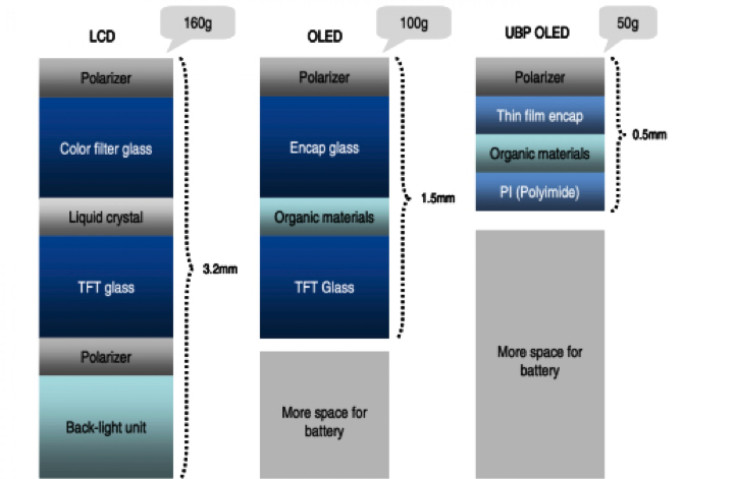Samsung Galaxy Note 3 To Feature Plastic OLED Display? First Device With 'Flexible' Screen?

Samsung may usher in the next generation of screen technology on the Galaxy Note 3 phablet as reports suggest the device will feature a newly developed plastic OLED display.
Information released by the OLED Association confirms that the Galaxy Note 3 will be unveiled at the IFA Expo in Berlin this September and that Samsung will introduce this new type of display made of a shatterproof plastic, which is thinner and lighter than the glass substrates that are currently used on devices, at the same event.

As pictured in a diagram, the thinner, lighter and more “flexible” display serves to make room for beefier batteries without making the device heavier. It could also potentially mean the Galaxy Note 3 will be slimmer than its predecessor, the Galaxy Note 2, despite being at least half an inch wider.
Plastic OLED Vs. Samsung Youm
We get an indication from the OLED Association that these flexible displays will be implemented into a conventionally flat-screened Galaxy Note 3, as opposed to the curved and roll-away displays that have been rumored about since Samsung unveiled its Youm flexible display at the Consumer Electronics Show, or CES, in January. Rumors surrounding Samsung Youm and other flexible display prototypes, such as one by Apple, suggest curved screen devices and devices with displays that can be rolled on or off and inserted within the device for safe housing.
Reports suggested that we may see such devices on the market by the end of the year, with the Galaxy Note 3 proposed among the first devices to receive the feature. Perhaps plastic OLED displays are the flexible display technology that we may see in the near future, which may then pave the way for innovations in the way devices are shaped.
It is also important to note that the OLED Association released its report in early April, while Samsung announced last week that issues with the encapsulation technology for flexible screens that protect them for moisture and oxygen may delay their commercialization and implementation into upcoming products.
Downside Of Plastic OLED Display

The Association notes one downside to the thinner yet tougher displays: They may not be suitable for full HD RGB resolution. Resolution information for the plastic OLED is notably missing in the comparison between the displays on the Galaxy Note 3 and the Galaxy Note 2. The association proposes that Samsung will likely not produce many of these displays and will sell Galaxy Note 3 handsets with plastic displays in select markets while most others will receive conventional glass displays.
The Galaxy S4 smartphone, which has begun its initial release and is set to launch in the U.S. this week, uses the third generation of Corning’s popular Gorilla Glass for its brilliant Full HD Super AMOLED display and is also thinner and lighter than its predecessor the Galaxy S3. The Galaxy Note 3 outfitted with a glass display will likely also use Gorilla Glass 3.
Other Galaxy Note 3 Rumors
There is plenty of time between now and the Galaxy Note 3’s projected release date in the fourth quarter for Samsung to decide the direction it will take with its upcoming Note device. Current rumors suggest that the Korean electronics giant also plans to introduce a metal exterior on the Galaxy Note 3 in order to compete with other companies like HTC and Apple that favor aluminum casings.
Nothing will be official until the phablet's alleged unveiling in September, which will reportedly be called "Mobile Unpacked: Episode 2," picking up where “Episode 1” left off when Samsung unveiled the Galaxy S4.
© Copyright IBTimes 2024. All rights reserved.












